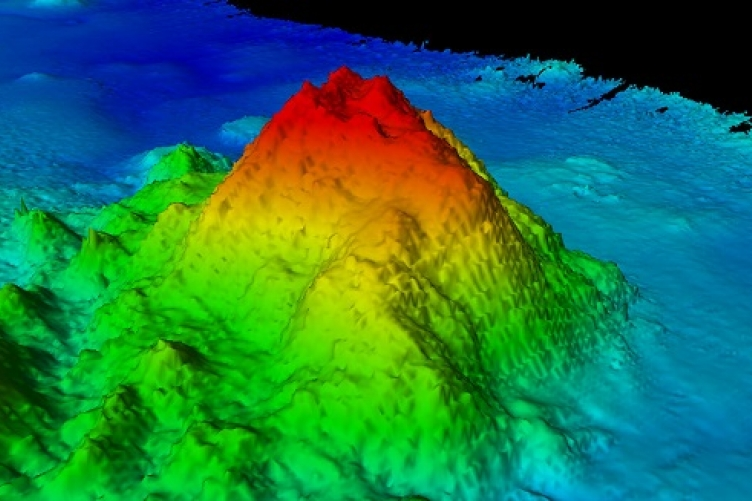Description

Disclaimer: Copyright infringement not intended.
Context
- The discovery of Crater Seamount in the Andaman Sea was made by a team of scientists from the National Institute of Oceanography (NIO).
Details
- The seamount has been located at a depth of 500 meters in the Andaman-Nicobar Volcanic arc, which has been a seismic zone of interest since it was first observed in 2007.
Geological Significance
- Crater Seamount is an underwater volcano, and its existence has been confirmed through extensive research and surveys.
- It is characterized by the presence of gas flares on its flanks, indicating ongoing volcanic activity.
- The volcano's location in the Andaman-Nicobar Volcanic arc suggests its association with tectonic and magmatic processes in the region.
Implications of the Discovery
- The discovery of an active submarine volcano in the Andaman Sea has significant implications for the region's geology and potential geological hazards.
- The volcano has the potential to erupt, leading to seismic events such as earthquakes and even tsunamis in the Java-Sumatra region.
- The precise timing of such an eruption cannot be predicted, making it important for monitoring and research efforts to understand the volcano's behavior.

Introduction to Seamount
A seamount is an underwater mountain or a submerged elevated area that rises from the ocean floor but does not reach the water's surface. These geological features are often found in the world's oceans and seas and can vary in size and shape.
Characteristics of Seamounts
- Formation: Seamounts are primarily formed through volcanic activity. They are the result of magma rising from the Earth's mantle through the oceanic crust. As the magma solidifies, it builds up to form a mountain-like structure on the seafloor.
- Shape: Seamounts can have various shapes, including conical, flat-topped, and elongated forms. Their shapes are influenced by the type of volcanic activity that created them.
- Size: Seamounts can range in size from small, isolated hills to massive underwater mountains that can extend for hundreds of kilometers. The height of seamounts above the seafloor varies widely as well.
- Location: Seamounts are found throughout the world's oceans, although they are more common in certain regions, such as the Pacific Ocean.
- Biodiversity: Seamounts are often hotspots for marine biodiversity. Their underwater peaks provide a substrate for the attachment of various marine organisms, and the upwelling currents around seamounts bring nutrient-rich waters, supporting diverse ecosystems.
Significance of Seamounts
- Habitat: Seamounts serve as important habitats for marine life. They attract a wide range of species, from corals and sponges to fish and sharks. Some species are specifically adapted to the unique conditions found on seamounts.
- Biodiversity: The biodiversity associated with seamounts can be exceptionally high, making them valuable for scientific research and conservation efforts. Many species discovered on seamounts are not found anywhere else.
- Fisheries: Seamounts are often targeted by commercial fisheries due to the concentration of marine life around them. This can lead to concerns about overfishing and the impact on seamount ecosystems.
- Geological Research: Seamounts provide valuable insights into the Earth's geological history and the processes that shape the ocean floor. They can be used to study plate tectonics, volcanic activity, and the movement of Earth's crustal plates.
- Ocean Currents: Seamounts can influence ocean currents and circulation patterns. Their presence can alter the flow of water masses, impacting regional climates and weather patterns.
Challenges and Conservation
- Overfishing: Due to the abundance of marine life around seamounts, they are vulnerable to overfishing. Conservation efforts are needed to protect these ecosystems and ensure sustainable fishing practices.
- Deep-sea Mining: Some seamounts contain valuable minerals and resources, leading to interest in deep-sea mining. This activity can have detrimental effects on seamount habitats and biodiversity.
- Climate Change: Seamount ecosystems may be affected by climate change, including ocean warming and acidification. These changes can impact the species that inhabit these areas.
- Research and Protection: Many seamounts remain poorly studied, and there is a need for further research to understand their ecological importance fully. Conservation measures, such as marine protected areas, can help preserve seamount ecosystems.
Notable Seamounts
- Davidson Seamount: Located off the coast of California, it is one of the most well-studied seamounts in the world and is known for its biodiversity.
- Hawaii-Emperor Seamount Chain: This chain of seamounts extends across the Pacific Ocean and includes the famous Mauna Loa and Mauna Kea, which are both volcanoes and seamounts.
- Mariana Trench: While not a seamount itself, this trench in the western Pacific Ocean contains numerous seamounts and is known for its extreme depth, including the Challenger Deep, the deepest point on Earth.
.jpg)
Conclusion
The discovery of Crater Seamount in the Andaman Sea by Indian scientists from the NIO is a significant contribution to our understanding of the region's geology and the potential geological hazards it may pose. Ongoing research and monitoring efforts are essential to assess the volcano's behavior and enhance preparedness for any future volcanic activity.
|
PRACTICE QUESTION
Q. Which of the following statements about seamounts is true?
1. Seamounts are geological features that breach the ocean's surface.
2. They are primarily formed through sedimentary processes.
3. Seamounts can serve as hotspots for marine biodiversity.
Select the correct option:
A)Only statement 1 is true.
B)Only statement 3 is true.
C)Statements 1 and 3 are true.
D)None of the statements are true.
Answer: C).
|
















